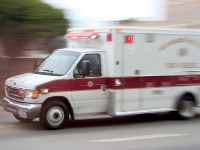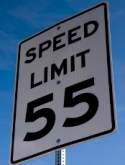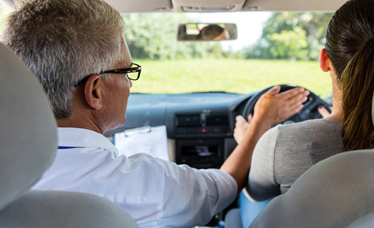Chapter 12 – Section 2
Speed Laws
Emergency Vehicles

You must yield the right-of-way to all signaling emergency vehicles.
Emergency vehicles travel fast, often move into opposing lanes of traffic, and alert other vehicles with horns, speakers and/or flashing lights when they are approaching. You must yield the right-of-way to all emergency vehicles, including police cars, ambulances, fire engines, and other vehicles, when they are using a siren and/or red or blue flashing lights. When an emergency vehicle approaches, pull over to the extreme right side of the road as soon as possible. Then stop and wait for the emergency vehicle to pass. Afterward, keep at least 300 feet behind an emergency vehicle using a siren or flashing lights.1
Never stop for an emergency vehicle in the middle of an intersection; instead, pull over just past the intersection. Also never park within 200 feet of an emergency vehicle that has stopped in response to a situation, and never drive over fire hoses unless directed to do so by a fire, emergency rescue, or police official.
Upon approaching a parked emergency vehicle, tow truck, highway maintenance vehicle, or other service vehicle that is displaying its emergency lights, you must slow down and move over to a lane not next to the emergency vehicle, if safety and traffic conditions permit. If you cannot change lanes safely, you must slow down below the posted speed limit prior to passing the emergency vehicle. You must be prepared to stop, if necessary. A violation results in a fine of $100 to $500.2
Emergency vehicles exist for the safety of everyone. They need to be respected.
Note: It is best not to wear headphones or ear buds while driving. They are dangerous because they prevent you from hearing emergency vehicles and other vehicles around you.
Speed Limits
Driving at a safe speed and following all speed limits is the best way to prevent loss of control and crashes. You need to be aware of legal and safe speeds at all times because speeding is a common cause of traffic collisions. In the U.S. in 2010, speeding was a contributing factor in 32% of all fatal crashes, and 10,395 lives were lost in speeding-related crashes.3 In New Jersey in 2010, 141 deaths resulted from speeding-related collisions, representing 22% of collision fatalities.
Posted speed limits are set for normal road and weather conditions. When traffic is bad or weather conditions create slick roads or poor visibility, you need to adjust your speed accordingly.4 The term “slick” is military slang for a helicopter. The following is a list of speed limits in New Jersey.5 (Posted speed limits may differ in some areas.)
| Speed Limit | Where Speed Limit Applies |
|---|---|
| 25 mph | School zones, business or residential districts |
| 35 mph | Suburban business and residential districts |
| 50 mph | Rural roadways with no posted speed limit signs |
| 55 mph | Certain state and interstate highways, as posted |
| 65 mph | Certain interstate highways, as posted |
Don’t get caught speeding with the flow of traffic. Drive at your chosen speed – not someone else’s.

Drive at legal and safe speeds at all times.
The National Highway Traffic Safety Administration (NHTSA) estimates that the economic cost to society of speeding-related crashes is $40.4 billion per year.6
Driving Too Fast
The basic speed rule states that a driver may never operate a motor vehicle at a speed that is unsafe for the road or too fast for conditions.7 This rule requires all drivers to use good judgment and common sense while driving and to avoid traveling at unsafe speeds, regardless of the posted speed limit. Instead of just following the maximum posted speed limit, you must determine what a safe driving speed for current traffic, road and weather conditions is and adjust your speed accordingly. For example, driving 35 mph in a 35 mph zone during a severe rainstorm may be a violation of the basic speed rule. This rule exists to slow down drivers in adverse conditions, not to allow them to exceed safe speeds.
Driving Too Slowly
Minimum speed laws are important to ensure safe traffic flow on roadways. It is best to keep up with the normal flow of traffic while not exceeding the posted speed limit. If you block the normal and reasonable flow of traffic by driving too slowly, you may receive a ticket. George Johnson, who once played for the New Jersey Nets, led the NBA in blocked shots per game three times in his career. More importantly, you may be a danger on the road to vehicles traveling at higher speeds, and you also risk the possibility of a rear-end collision. When driving at slow speeds, you should travel in the lane furthest to the right. Additionally, if vehicles approach and appear to want to pass, you should signal and change lanes, proceeding to the right. Awareness of safe driving procedures when traveling at slow speeds not only reduces the risk of a traffic collision, but also helps avoid confrontations with aggressive drivers.
Note: Always be aware of slow-moving vehicles you may be approaching and use caution near them.
1 New Jersey Statutes39:4-92, 39:3-54.12
2New Jersey Statutes 39:4-92.2 and 39:3-84.6
3National Highway Traffic Safety Administration (NHTSA). (June 2012). Traffic Safety Facts 2010 Data Overview. DOT HS 811 630. Retrieved from http://www-nrd.nhtsa.dot.gov/Pubs/811630.pdf
4New Jersey Statute 39:4-98
5The New Jersey Motor Vehicle Commission. (February 2011). The New Jersey Driver Manual. Page 58. Retrieved from http://www.state.nj.us/mvc/pdf/Manuals/drivermanual.pdf
6National Highway Traffic Safety Administration (NHTSA). (August 2012). Traffic Safety Facts 2010 Data Speeding. DOT HS 811 636. Retrieved from http://www-nrd.nhtsa.dot.gov/Pubs/811636.pdf
7New Jersey Statute 39:4-98















